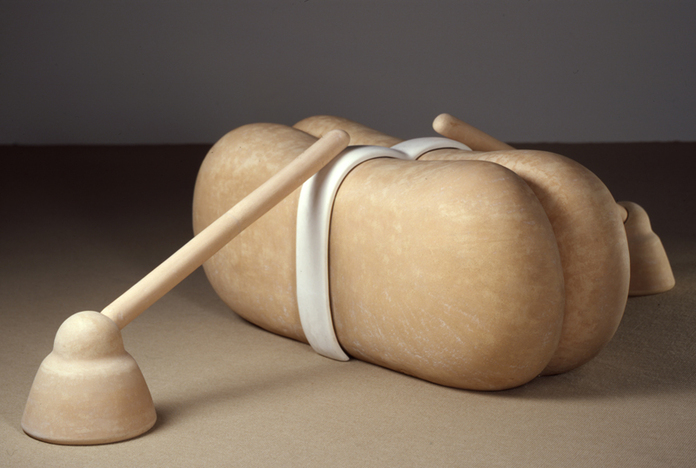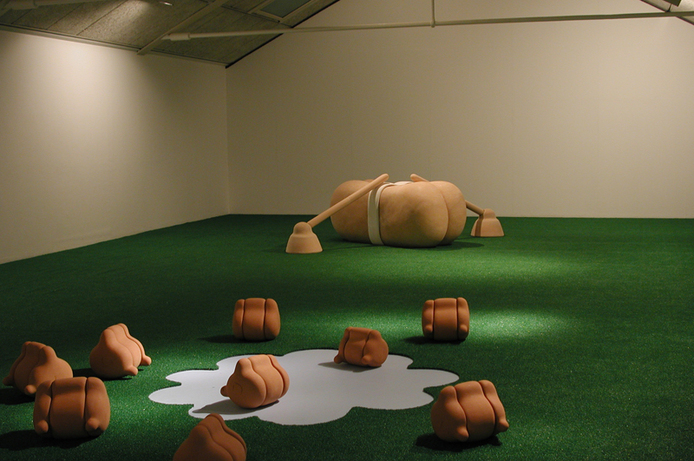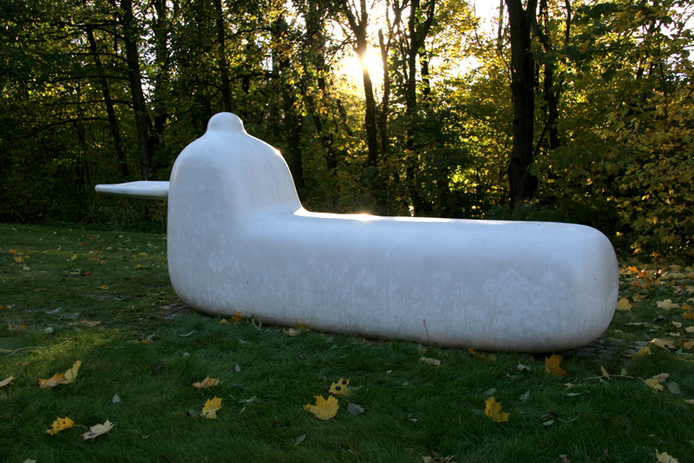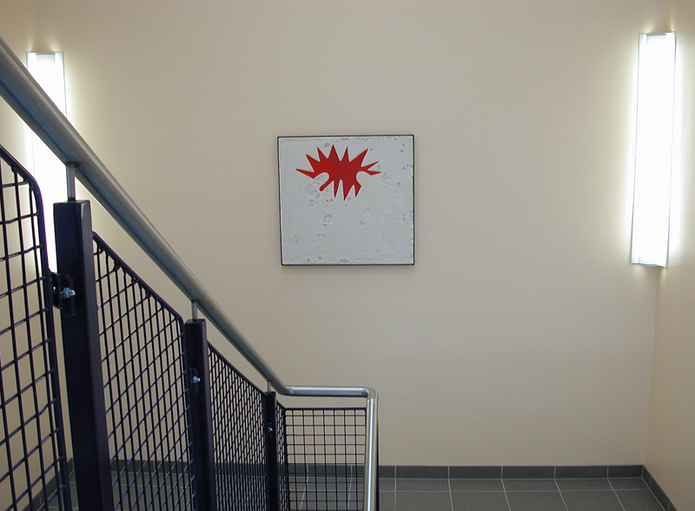Project proposal for British Ceramics Biennial 2013

For the BCB 2013 I want to propose a project that builds further on my experiences and research outcomes of the two previous workshops at Spode Works. I would like to create an installation that bridges the two projects into a hybrid situation. If I get accepted I plan to spend up to two weeks on site to install the installation this August.
In September 2012 I started to paraphrase and rephrase found objects from the SPODE site into sculptural structures. The work on assembling the sculptures was intuitive and playful. What could work together from an aesthetic or formalistic perspective? By putting together stuff that don´t belong together you realize that the sum of the parts sometimes are greater than each individual part. I found it interesting to observe this, and how different constellations sometimes made an absurd connection or comment to this site and its history.
The work I produced during September 2012 doesn’t appear to be site-specific at first sight. It is presented like autonomous sculpture, but all of the material has some kind of relationship to the closed down production at Spode Works. So when it´s presented in these particular surroundings it links up with the past and the future of the site.
In the second part of this project, "Topographies of the Obsolete", which happened this spring, I wanted to work in the same space were I assembled and displayed the sculptures. During my first stay I had noticed that the space had some interesting perforations in the sealing structure. These features were suggesting that the space itself were, or at least could become, a sculptural body in its own right.
My initial idea was to stich up the holes in the sealing with some kind of rope or tread. When I came down to start up the project it was still in a limbo, because I didn´t at that point have a material that could work visually or conceptually. The rope/tread had to have some kind of unspecified aesthetic quality that could work in that setting, and finally it had to be found at the site. (Anything else felt like cheating).
By pure luck I found several rolls of so called IBM multi purpose ribbons. These are ink saturated nylon ribbons for printer devices. These ribbons made a clear “drawing” in the space when suspended between the structural elements.
As a physical action the ”stitching” of the space emphasises its sculptural properties.
Such an infiltration aims to voice the poetics hidden in the space. Highlighting the now missing veins and arteries of the architectural body, altering and negotiating the viewer perception and experience. The now restraining ribbons, another reminiscence of the sites history, and dislocated, from its former function, could also symbolize the crumbling suspense present in a continuous decaying ruin or a derelict location.
Both projects and the one that I now propose for relates to the ceramic as a subject.
In September 2012 I started to paraphrase and rephrase found objects from the SPODE site into sculptural structures. The work on assembling the sculptures was intuitive and playful. What could work together from an aesthetic or formalistic perspective? By putting together stuff that don´t belong together you realize that the sum of the parts sometimes are greater than each individual part. I found it interesting to observe this, and how different constellations sometimes made an absurd connection or comment to this site and its history.
The work I produced during September 2012 doesn’t appear to be site-specific at first sight. It is presented like autonomous sculpture, but all of the material has some kind of relationship to the closed down production at Spode Works. So when it´s presented in these particular surroundings it links up with the past and the future of the site.
In the second part of this project, "Topographies of the Obsolete", which happened this spring, I wanted to work in the same space were I assembled and displayed the sculptures. During my first stay I had noticed that the space had some interesting perforations in the sealing structure. These features were suggesting that the space itself were, or at least could become, a sculptural body in its own right.
My initial idea was to stich up the holes in the sealing with some kind of rope or tread. When I came down to start up the project it was still in a limbo, because I didn´t at that point have a material that could work visually or conceptually. The rope/tread had to have some kind of unspecified aesthetic quality that could work in that setting, and finally it had to be found at the site. (Anything else felt like cheating).
By pure luck I found several rolls of so called IBM multi purpose ribbons. These are ink saturated nylon ribbons for printer devices. These ribbons made a clear “drawing” in the space when suspended between the structural elements.
As a physical action the ”stitching” of the space emphasises its sculptural properties.
Such an infiltration aims to voice the poetics hidden in the space. Highlighting the now missing veins and arteries of the architectural body, altering and negotiating the viewer perception and experience. The now restraining ribbons, another reminiscence of the sites history, and dislocated, from its former function, could also symbolize the crumbling suspense present in a continuous decaying ruin or a derelict location.
Both projects and the one that I now propose for relates to the ceramic as a subject.
Topographies of the Obsolete

Installation view (2013)
Resurrecting the Obsolete: Exploring the Site Specific and Associated Histories of Post- Industry was an artistic research workshop which took place in September 2012 in the Spode Factory, Stoke on Trent, UK organized by Bergen Academy of Art and Design, Norway (KHiB) who was invited as a Research Fellow Partner Institution by the British Ceramics Biennial 2013. The workshop included 33 staff and students from KHiB, The Royal Academy of Art Copenhagen, Muthesius Kunsthochschule Kiel, Sheffield Hallam Univerisity, University of Nottingham Trent and invited alumni/artists from KHiB. Together we explored the Spode site’s histories, industrial space and infrastructure.
The initial workshop uncovered a variety of methods and strategies exploring the complexity of the site from different perspectives and practices particular to each of the artists/students involved. We had a great variation of expressions ranging from the performative intervention based to installation and object based work. Participating teachers/artists worked from the foundations of their individual research methods, and the site offered multi-faceted scope for creative interpretation through its socio-economic histories, industrial architecture, and production and material remnants. The continuation of the research residency takes place in March 2013 as the artistic research project Topographies of the Obsolete.
The initial workshop uncovered a variety of methods and strategies exploring the complexity of the site from different perspectives and practices particular to each of the artists/students involved. We had a great variation of expressions ranging from the performative intervention based to installation and object based work. Participating teachers/artists worked from the foundations of their individual research methods, and the site offered multi-faceted scope for creative interpretation through its socio-economic histories, industrial architecture, and production and material remnants. The continuation of the research residency takes place in March 2013 as the artistic research project Topographies of the Obsolete.
Resurrecting the Obsolete

Meadow (2012)
Works from a workshop in the artistic research project "Resurrecting the Obsolete”: Exploring the Site Specific and Associated Histories of Post-Industry" which took place in September in Stoke on Trent, England.
An intense and focused workshop at Spode Factory site in Stoke on Trent, with an impressive commitment from both staff and students from KHiB, created the starting point of the artistic research project "Resurrecting the Obsolete: Exploring the Site Specific and Associated Histories of Post-Industry".
This is a work in progress and is a result of an R&D workshop in Stoke-on-Trent, England. This is part of a collaborative project between KHiB, partner institutions and British Ceramic Biennale involving both staff and students. The show will also feature Professor Neil Brownsword's work which explores the social, cultural, and economic impact of the decline of British ceramic manufacture in Stoke-on-Trent, his hometown and where the Spode factory is located.
The project in progress aims to explore the Spode site's histories, industrial space and infrastructure. The site offers multi-faceted scope for creative interpretation through its socio-economic histories, industrial architecture, production and material remnants. It entails a variety of methods and strategies in order to explore the complexity of the site from different perspectives and combine the individual practices of the participants.
From Department of Fine Art at KHiB
An intense and focused workshop at Spode Factory site in Stoke on Trent, with an impressive commitment from both staff and students from KHiB, created the starting point of the artistic research project "Resurrecting the Obsolete: Exploring the Site Specific and Associated Histories of Post-Industry".
This is a work in progress and is a result of an R&D workshop in Stoke-on-Trent, England. This is part of a collaborative project between KHiB, partner institutions and British Ceramic Biennale involving both staff and students. The show will also feature Professor Neil Brownsword's work which explores the social, cultural, and economic impact of the decline of British ceramic manufacture in Stoke-on-Trent, his hometown and where the Spode factory is located.
The project in progress aims to explore the Spode site's histories, industrial space and infrastructure. The site offers multi-faceted scope for creative interpretation through its socio-economic histories, industrial architecture, production and material remnants. It entails a variety of methods and strategies in order to explore the complexity of the site from different perspectives and combine the individual practices of the participants.
From Department of Fine Art at KHiB
- Neil Brownsword, Professor;
- Duncan Higgins, Associate Professor;
- Richard Launder, Associate Professor;
- Rita Marhaug, Professor;
- Anne Helen Mydland, Professor;
- Heidi Nikolaisen, Assistant Professor;
- Sabine Popp; Assistant Professor;
- Tone Saastad, Assistant Professor;
- Johan Sandborg, Associate Professor;
- Øyvind Suul, Associate Professor;
- Herbert Wigand, Assistant Professor.
- The Royal Academy of Fine Arts, Copenhagen;
- Muthesius Academy of Fine Arts and Design, Kiel;
EXTENDED VERSION - SCULPTURAL REMIX
The aim of this project is to create and explore flexible three dimensional systems
by developing sculptural elements that can easily be manipulated into new contexts by adding and/or subtracting visual information.

TWINS, 1st & 2nd edition (2002)
The questions asked in this project will investigate both “introvert” sculpture, as well as staged situations where the surroundings “shed light” upon the three dimensional objects. It is possible to do research within this field by approaching the process and the physical results systematically. What is the cause and effect of different attachments of visual information that separately communicate on different levels?

LEGEND (2000)
My aim is not to create standardized approaches or certain sculptural attributes for everyone to use, but the results of the project will contribute to a general increase of competence within subject areas concerned with further developing sculpture as artistic expression.

LEGEND (Installation view), RAM Gallery (2000) Oslo, Norway
Harald Schjeldrups Hus, Universitetet i Oslo. Kunstverk til Psykologisk Institutts nybygg. 2005/2006

Skulpturene som er plassert foran og bak Harald Schjeldrups hus er en sammen-smeltning mellom organiske og industrielle inspirasjonskilder. Målsettningen var å åpne for flere mulige assosiasjoner hos betrakteren. I dette prosjektet har jeg vektlagt assosiasjoner knyttet til menneskekroppen. Tittelen på arbeidene; ”Twins” og ”Blend of nature”, kan være verktøy og/eller et uromoment for tilskueren.

Jeg ønsker i utgangspunktet at publikum skal være frie i sine tolkninger, men gjennom valg av tittel styrer jeg publikums tilnærming. Denne innfallsvinkelen representerer imidlertid ingen vesentlig begrensning av mulige tolkninger, selv om den legger visse føringer. For å låne en betraktning fra Roland Barthes, så er tittelens oppgave å forankre kunstverket. I havet av mulige tydninger og tolkninger, representerer tittelen et ankerfeste og et orienteringspunkt som assosiasjonene styres fra. Frasen ”My wife and my mother-in-law” er benevnelsen på en berømt persepsjonsillusjon fra slutten av 1800 tallet, hvor betrakterens hjerne skifter mellom å se en ung kvinne og en eldre dame (eller ”kone” og ”svigermor”). Fremstillingen er et eksempel på det spenningsfeltet som oppstår når det med overlegg er plantet motstridene og spesifike koder i en visuell komposisjon.
Selv søker jeg alltid etter visuelle kombinasjoner som kan skape tvetydighet. Summen av assosiasjoner former et visuelt spørsmål som er bygd opp av mulige fellesnevnere i betrakterens kulturelle og erfaringsmessige bakgrunn.
De er ofte både positivt og negativt ladet og derfor istand til å fremmbringe så vel ubehaglige som humoristiske assosiasjoner.En av forutsetningene som var lagt til grunn for prosjektet var at skulpturene skulle ha integrert sittefunksjon. Noe av utfordringen var derfor å smelte disse egenskapene sammen med et kunstnerisk uttrykk på en mest mulig subtil måte. Skulpturene ble støpt i hvit betong. Et lyst uttrykk gir spillerom for lys- og
skyggevirkninger slik at formene blir eksponert på en tydelig måte. En hvit overflate fungerer også som en
nødvendig og tydelig kontrast mot omgivelsene.
Utsmykning til Persbråten videregående skole, 2001-2002.
Prosjektet hadde fokus på det estetiske og på å skape noen fokuspunkter i bygget hvor det var flere nakne veggpartier. Oppbyggningen av relieffene foregikk ved å brenne fast farger og strukturer til underlaget. Brenningene skjedde ved forskjellige temperaturer og dette krevde en viss grad av planmessighet i forkant av selve arbeidsprosessen. I praksis betyde dette at keramiske virkemidler som krevde høy temperatur, ble brent før de som
krevde lavere varme. Eksempelvis vil en brenning til 1000 grader celsius ødelegge eller i beste fall forandre farger og virkninger som er fremstilt ved 800 grader. Antall brenninger varierte mye fra arbeid til arbeid.

Verken arbeidsmetoden eller de estetiske virkemidlene som jeg benyttet meg av, viser seg å være avhengige av et spesielt leireunderlag. Forutsetningen er at materialet tåler sterk varme og at keramiske virkemidler som glasur og leire fester seg ved brenning. Ad omveier dukket keramiske ovnsplater opp som et godt alternativ til leire.
Ovnsplater som substitutt
Ovnsplatenes styrke som underlag ligger i deres tekniske forutsigbarhet. Ovnsplatenes egenskaper under høye temperaturer sørger for at de, og det arbeidet som er lagt inn i dem, overlever ekstreme brenningsprosesser. Platene hverken sprekker, krymper og/eller slår seg under brenning, slik som flak av leire kan ha en tendens til. Svinn eksisterer derfor ikke. Disse faktorene, pluss tidsbesparelsen ved å slippe å tilvirke underlagene selv, gjør at ovnsplatene blir konkurransedyktige også på pris.
Ovnsplatene kan uten problemer lages eller kuttes i forskjellige størrelser. Platenes presise finish gjør de velegnet som moduler i en større helhet.
Relieffene som ble laget til nybygget på Persbråten v. g. skole ble montert i stålrammer. I alt 20 arbeider er plasert på forskjellige steder i bygget. De største relieffene måler
70x70 cm (7 stk) de minste er 40x40 cm. (For flere bilder gå til Commissions i menyen)